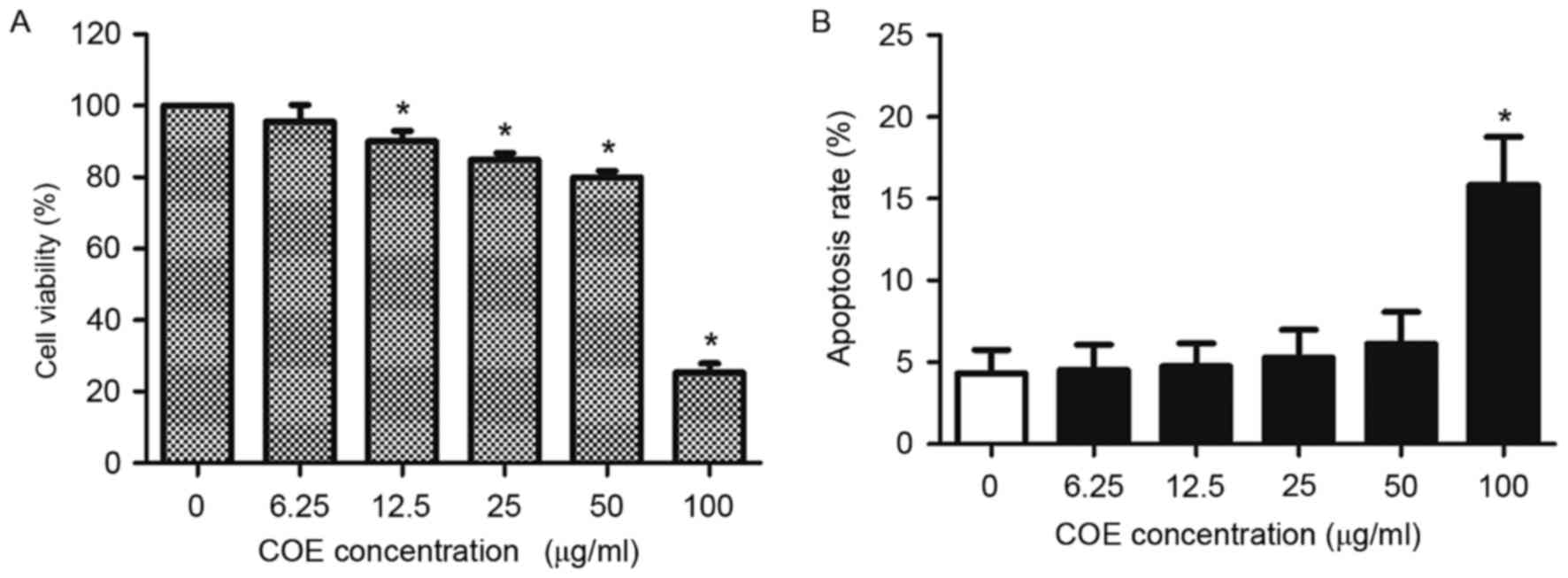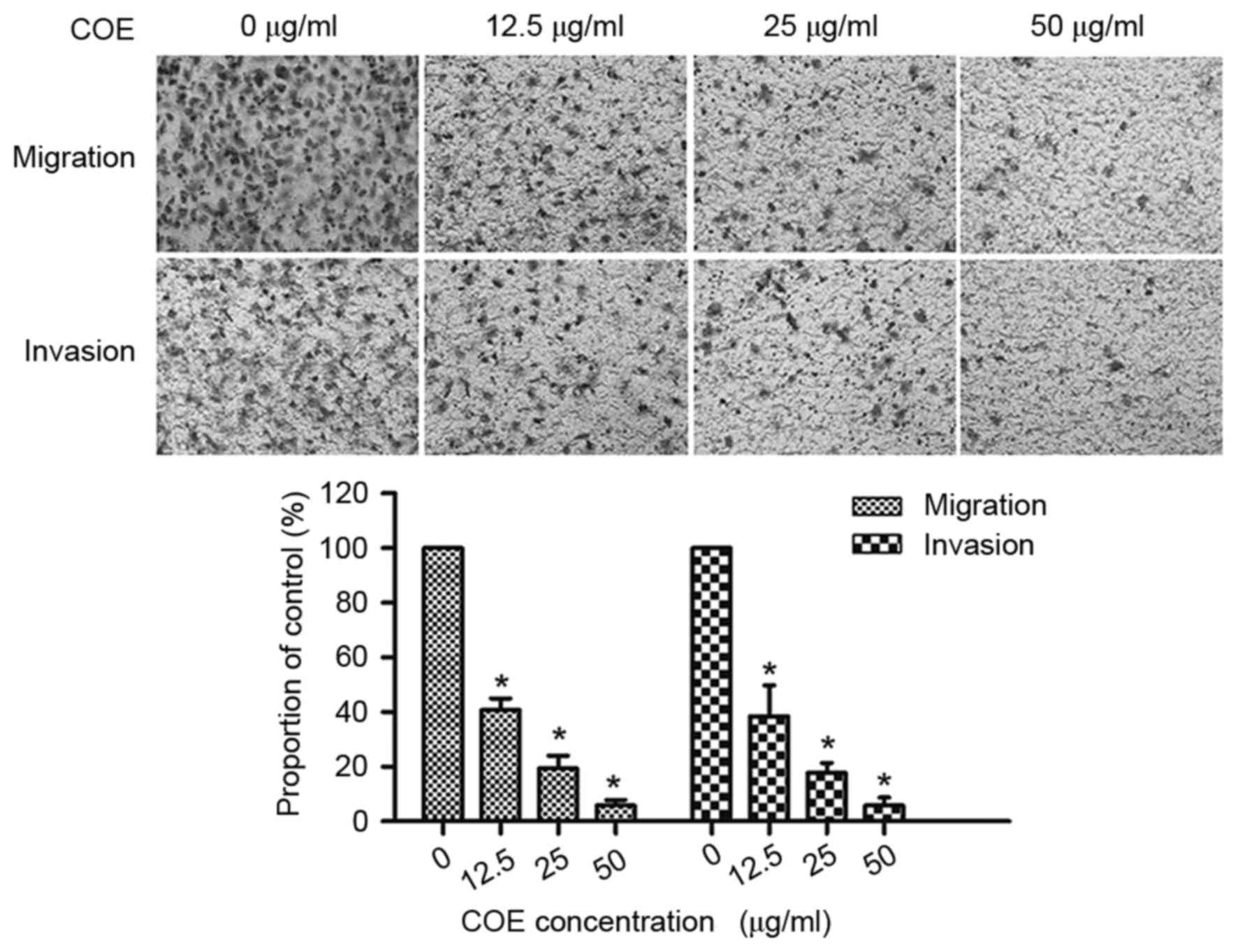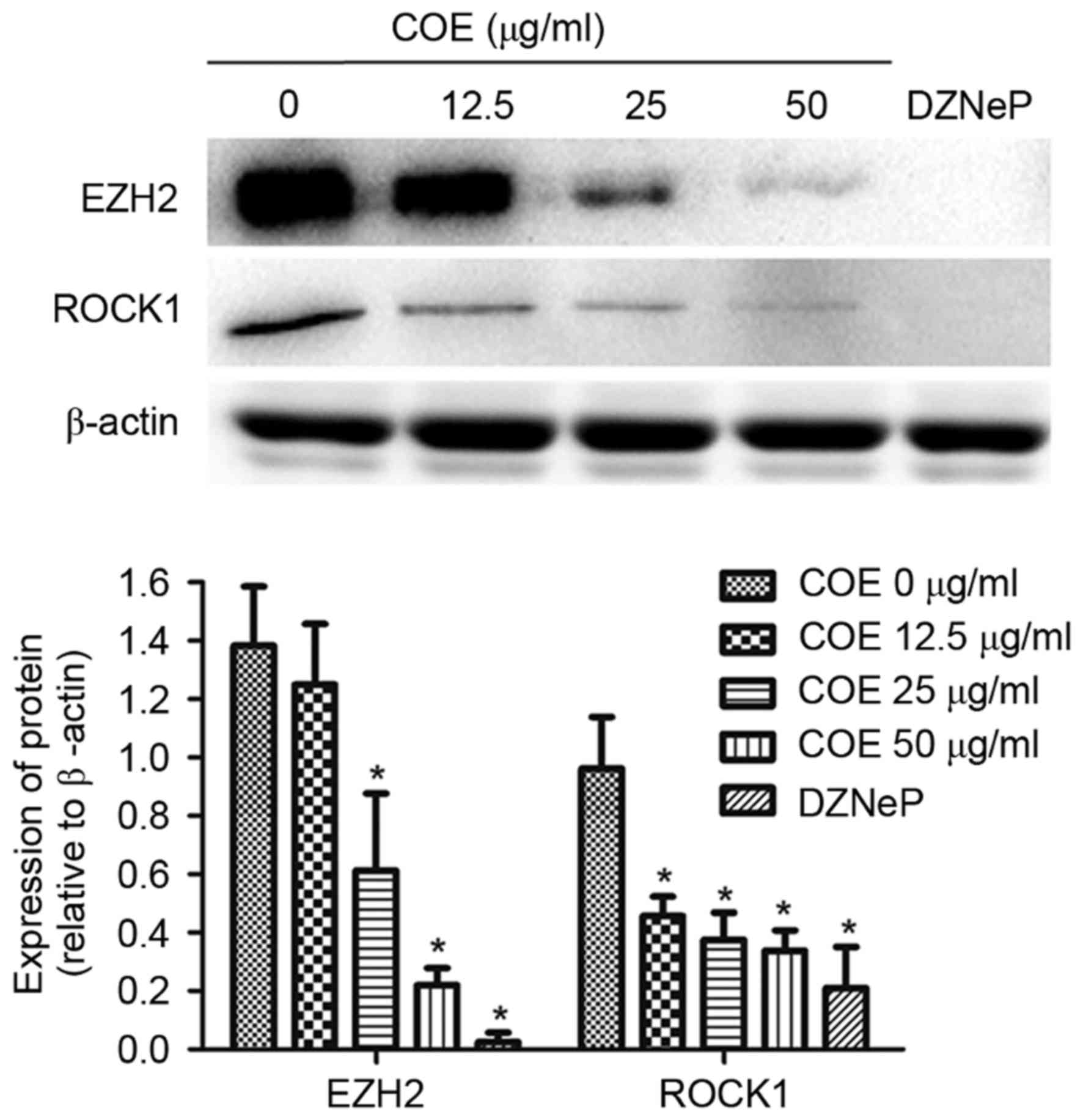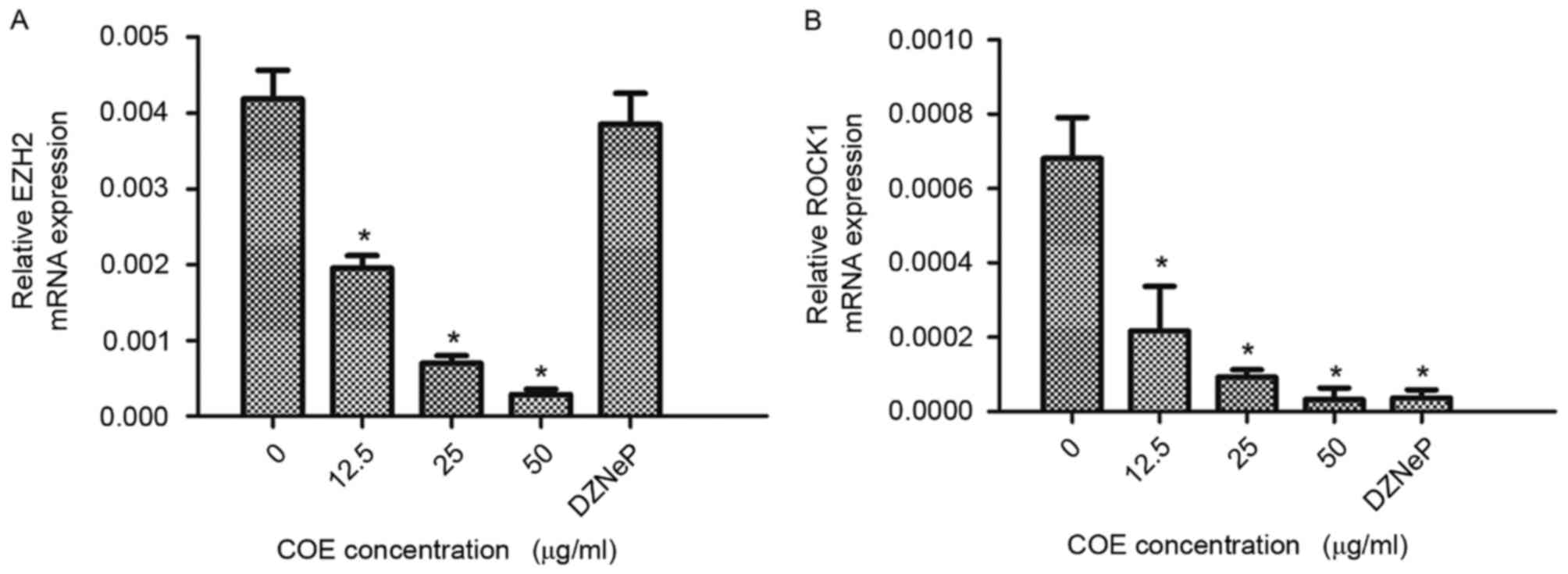Efficacy of extracts of Celastrus orbiculatus in suppressing migration and invasion by inhibiting the EZH2/ROCK1 signaling pathway in human nasopharyngeal carcinoma
- Authors:
- Published online on: March 1, 2018 https://doi.org/10.3892/ol.2018.8149
- Pages: 6695-6700
Abstract
Introduction
China has the highest incidence and mortality rate of nasopharyngeal carcinoma (NPC), a type of malignant epithelial cell tumor, worldwide (1). NPC exhibits decreased differentiation and a high metastatic nature which frequently causes local regional recurrence and distant metastasis in patients (2), and is the primary reason for failure of treatment. Therefore, it is important to investigate the underlying molecular mechanism of migration and invasion in NPC.
The enhancer of zeste homolog 2 (EZH2) is a core component of the Polycomb repressive complex 2 which possesses a highly conserved SET domain with histone methyltransferase activity. Previous studies have identified that EZH2 was overexpressed in a variety of carcinomas including NPC, prostate cancer and breast cancer. The expression levels of EZH2 were associated with tumor size, depth of invasion, tumor stage, lymph node metastasis, migration and invasion ability, suggesting that EZH2 had the potential to be a novel diagnosis biomarker and a target for antitumor therapy in NPC (3–5).
Rho-associated coiled-coil-containing protein kinase (ROCK) is a RhoA downstream effector protein. ROCK1 is one of the isoforms of ROCK and serves a critical role in the regulation of cell migration and the maintenance of cell migration (6,7).
Previous studies have demonstrated that an ethyl acetate extract of Celastrus orbiculatus (COE), a traditional Chinese herb, has a marked antitumor effect in liver cancer, gastric cancer and other tumors (8–10). In addition, it has been revealed that COE is able to inhibit tumor metastasis in gastric cancer (8). The results of these studies suggested that COE may also have the ability to inhibit the invasion and metastasis of NPC cells, the validation of which was an aim of the present study.
In the present study, the effects of COE on migration and invasion in vitro were investigated, in addition to the underlying molecular mechanism. The results indicated that COE inhibited the invasion by suppressing the EZH2/ROCK1 signaling pathway in NPC cells. Therefore, it is suggested that COE may have therapeutic effects against NPC via the EZH2/ROCK1 signaling pathway.
Materials and methods
Reagents and antibodies
RPMI-1640 medium and fetal bovine serum (FBS) were acquired from Gibco; Thermo Fisher Scientific, Inc. (Waltham, MA, USA). The Cell Titer 96 Aqueous One solution cell viability assay (MTS assay) was purchased from Promega Corporation (Madison, WI, USA). Matrigel was purchased from BD Biosciences (San Jose, CA, USA). Primary antibodies used were: Rabbit anti-EZH2 (cat. no. ab186006; 1:1,000; Abcam, Cambridge, MA, USA), rabbit anti-ROCK1 (cat. no. ab45171; 1:2,000; Abcam) and rabbit anti-β-actin (cat. no. 4970; 1:1,000; Cell Signaling Technology, Inc., Danvers, MA, USA). The secondary antibody used was: Horseradish peroxidase (HRP)-conjugated goat anti-rabbit immunoglobulin (Ig)G (cat. no. HA1001-100; 1:2,000; HuaAn Biotechnology Co., Hangzhou, China). Chemical reagents used were: 3-Deazaneplanocin A (DZNeP; Sigma-Aldrich; Merck KGaA, Darmstadt, Germany) and dimethyl sulfoxide (DMSO; Sigma-Aldrich; Merck KGaA). Other chemicals used were of analytical grade from commercial sources.
Plant materials
Plant materials were purchased from Guangzhou RiboBio Co., Ltd. (Guangzhou, China). COE was obtained in the Department of Chinese Materia Medica Analysis in China Pharmaceutical University (Nanjing, China), according to a previously published protocol (11,12). The resultant COE micropowder was dissolved in DMSO and diluted with RPMI-1640 medium to various concentrations (6.25, 12.5, 25, 50 and 100 µg/ml).
Cell culture
The human NPC cell line 5–8F was a gift from Fudan University Cancer Hospital (Shanghai, China). The cell line was maintained in RPMI-1640 medium and supplemented with 10% FBS, 100 U/ml penicillin and 100 mg/ml streptomycin at 37°C in a humidified atmosphere containing 5% CO2.
MTS cytotoxicity assay
The Cell Titer 96 Aqueous One solution cell viability assay (MTS assay) was performed according to the manufacturer's protocol. Cells were seeded in 96-well plates (100 cells/well) and incubated at 37°C overnight for attachment. Subsequently, cells were treated with various doses of COE (0, 6.25, 12.5, 25, 50 and 100 µg/ml) for 24 h. A 20 µl volume of MTS reagent was added to each well and incubated at 37°C for 2 h. Subsequently, the absorbance was measured at 450 nm using a microplate reader.
Assessment of apoptosis by flow cytometry
The Annexin V-fluorescein isothiocyanate (FITC) apoptosis detection assay was performed according to the manufacturer's protocol (Bipec Biopharma Corporation, Cambridge, MA, USA). After 24 h of incubation at 37°C with COE, cells were harvested using trypsin and washed twice in PBS. Cells were then re-suspended in 400 µl with 1X binding buffer at a concentration of 1×106 cells/ml prior to the addition of 5 µl Annexin V-FITC. Cells were then vortex-mixed and incubated for 15 min at between 4 and 8°C in the dark. A 10 µl volume of propidium iodide was added to each tube before incubation for another 5 min at between 4 and 8°C in the dark. The stained cells were analyzed using flow cytometry by FlowJo version 7.6 software (BD Biosciences).
Cell invasion and migration assays
Cell invasion and migration assays were performed using a Transwell membrane (Corning Incorporated, Corning, NY, USA) according to the manufacturer's protocol. In the invasion assay, Matrigel was applied to the upper chamber. Following treatment with various concentrations (0, 12.5, 25 and 50 µg/ml) of COE, 5–8F cells (1×105 /well) were seeded into the upper chamber. RPMI-1640 medium containing 10% FBS was added to the lower chamber. After 24 h of incubation at 37°C, cells on the upper membrane surface were removed using a cotton swab and cells on the lower membrane surface were fixed with 4% paraformaldehyde and stained with crystal violet. The controls of these experiments were cells treated with 0 µg/ml COE. The number of invading cells was counted for each chamber in five random fields (magnification, ×200) by an Olympus IX73 fluorescence microscope (Olympus Corporation, Tokyo, Japan) and were captured by digital camera (Olympus Corporation). For the migration assays, the procedures were carried out in the same way, with the exception that the upper membrane was not coated with Matrigel. Each experiment was performed three times.
Quantification of ROCK1 mRNA expression by reverse transcription-quantitative polymerase chain reaction (RT-qPCR)
Total RNA was extracted from the COE-treated cells using the TRIzol® reagent (Life Technologies; Thermo Fisher Scientific, Inc.), and RT was performed in a 20 µl reaction with 200 ng total RNA using the Two Step RT PCR kit (Takara Biotechnology Co., Ltd., Dalian, China). The RNA concentration was assessed by measuring the absorption (A260/A280) on the NanoDrop Spectrophotometer ND-1000 (NanoDrop, Wilmington, DE, USA). RT was performed under the following conditions: 37°C for 15 min, 85°C for 5 sec, and then held at 4°C until use. RT-qPCR was performed in triplicate using SYBR Premix Ex Taq™ kit (Takara Biotechnology Co., Ltd., Dalian, China) on a LightCycler® 480 Real-Time PCR system. The primers used are presented in Table I. qPCR was performed under the following conditions: Initiation step at 95°C for 30 sec for one cycle, denaturation step at 95°C for 5 sec and 60°C for 30 sec for 40 cycles, annealing at 95°C for 5 sec and 60°C for 1 min for one cycle, and an elongation step at 50°C for 30 sec for 1 cycle. mRNA levels of EZH2 and ROCK1 were measured by the relative fluorescent intensity to the internal control β-actin using the 2−ΔΔCq method (13).
Western blot analysis
Protein expression levels were analyzed by western blot analysis. Experiments were performed at least three times. The cells were scraped into 0.3 ml lysis buffer on ice. Cell debris was removed by centrifugation (12,000 × g, 4°C, 10 min). The protein concentrations were quantified using the Bradford method. A total of 30 µg protein/lane was separated by SDS-PAGE (5–10% gel) and transferred onto polyvinylidine difluoride membranes (Immobilon; EMD Millipore, Billerica, MA, USA). The membranes were blocked with 5% bovine serum albumin and incubated overnight at 4°C with primary antibodies. Following three washes with TBST, the membranes were incubated for 2 h at room temperature with HRP-conjugated goat anti-rabbit IgG. Immunoreactive protein bands were detected using an enhanced chemiluminescence system (GE Healthcare Life Sciences, Chalfont, UK). To quantify protein levels of the western blots, densitometric analysis was performed using ImageJ v1.46 software (National Institutes of Health, Bethesda, MD, USA).
Statistical analysis
SPSS software (version 16.0; SPSS, Inc., Chicago, IL, USA) was used to analyze the results of the present study. Results are presented as the mean ± standard deviation and assessed by the two-tailed Student's t-test. To quantify protein levels of western blots, densitometric analysis was performed using ImageJ software (version 1.46; National Institutes of Health, Bethesda, MD, USA). P<0.05 was considered to indicate a statistically significant difference. Experiments were performed at least three times.
Results
Effect of COE on viability of 5–8F cells
COE decreased viability of 5–8F cells in a concentration-dependent manner (Fig. 1A). Additionally, COE increased the apoptotic rate of 5–8F cells in a concentration-dependent manner (Fig. 1B). However, no significant difference in the apoptotic rates of 5–8F cells was identified for doses <100 µg/ml COE for 24 h. Therefore, concentrations <100 µg/ml COE were selected for the subsequent experiments, to ensure that the effect of COE on NPC cells was not caused by direct cytotoxicity of COE.
COE inhibits migration and invasion in 5–8F cells
COE markedly decreased the number of cells which migrated and invaded the lower chamber, in a dose-dependent manner. As presented in Fig. 2, treatment with COE (12.5, 25 and 50 µg/ml) inhibited 59.3, 80.6 and 94.21% of cell migration and inhibited 61.54, 82.2 and 94.23% of cell invasion in 5–8F cells, respectively. The results of the present study identified that COE inhibited migration and invasion of 5–8F cells in a dose-dependent manner.
COE inhibits protein expression of EZH2 and ROCK1 in 5–8F cells
To determine the underlying molecular mechanism of COE in NPC cells, the expression levels of EZH2 and ROCK1 were analyzed. Treating cells with COE decreased EZH2 and ROCK1 protein expression levels in a dose-dependent manner. EZH2 and ROCK1 protein expression levels were significantly decreased following treatment with COE at 50 µg/ml and 2 µM DZNeP, an inhibitor of EZH2, for 24 h (Fig. 3).
COE inhibits mRNA expression of EZH2 and ROCK1 in 5–8F cells
RT-qPCR was used to determine mRNA expression levels of EZH2 and ROCK1 in 5–8F cells. Cells treated with COE exhibited decreased EZH2 and ROCK1 mRNA expression levels in a dose-dependent manner. RT-qPCR revealed that EZH2 mRNA expression levels were significantly decreased following treatment with COE at 50 µg/ml for 24 h; however, a similar effect was not observed with DZNeP treatment. ROCK1 mRNA expression levels were significantly decreased following treatment with various doses of COE and 2 µM DZNeP for 24 h. Results are presented in Fig. 4. The results of the present study suggest that expression levels of EZH2 and ROCK1 mRNA were significantly decreased by COE in a dose-dependent manner in 5–8F cells.
Discussion
COE serves diverse roles in antitumor activity through modulation of cell viability, apoptosis, angiogenesis, invasion and metastasis. Although a number of studies have suggested that the COE is associated with tumor metastasis (8,14), its function in the EZH2/ROCK1 signaling pathway remains unclear. To identify potential therapeutic targets, elucidating the underlying molecular tumorigenic mechanisms of COE is required.
EZH2 overexpression has been identified in NPC, non-small cell lung cancer, chronic lymphocytic leukemia and breast cancer (15–17). Collectively, these studies suggest that EZH2 is a novel target oncogene and pharmacological inhibition of EZH2 may be therapeutic for certain types of cancer.
The ROCK signaling pathway is one of the most important cellular invasion mechanisms. Activated Rho GTP binds to ROCK, changing the conformation of ROCK and exposing the catalytic domain so that downstream effector molecules may be phosphorylated. Subsequently, ROCK reorganizes the cytoskeleton and promote formation of focal adhesion (18). Previous studies have demonstrated that the regulation of human lung cancer cell movement by placental growth factor is primarily due to ROCK (19,20). Therefore, ROCK1 is associated with cancer growth, invasion and metastasis, and may be a target of tumor metastasis.
In order to determine the effect of COE on the EZH2/ROCK1 signaling pathway, a series of experiments were conducted in NPC cells. The function of COE was determined using an MTS cytotoxicity assay and flow cytometry. The increased dose of COE may be attributed to the decreased viability capacity and increased apoptotic rates.
The results of the present study demonstrated that COE serves a crucial role in decreasing tumor migration and invasion by regulation of the EZH2/ROCK1 signaling pathway. COE inhibited invasion and migration of 5–8F cells at low-toxic doses (12.5, 25 and 50 µg/ml), suggesting that inhibition of invasion and migration of 5–8F cells by COE was not due to its cytotoxic effect.
EZH2 and ROCK1 protein and mRNA expression levels were significantly decreased following COE treatment. The abrogation of EZH2 function by DZNeP decreased the protein and mRNA expression levels of ROCK1; however, DZNeP decreased the protein expression levels of EZH2 only. The results of the study of Girard et al (21) were consistent with those of the present study; DZNeP decreased protein expression levels, but not mRNA expression levels, of EZH2 in chondrosarcoma cells. The results of the present study, together with those of Girard et al (21), indicated that DZNeP may regulate EZH2 expression levels at the post-transcriptional level.
Previous studies have demonstrated that EZH2 is upregulated in NPC tissues. Overexpression of EZH2 was associated with an advanced clinical stage and increased risk of relapse, and EZH2 served as an independent poor prognostic factor for patients with NPC (3,22). Therefore, ROCK1 may be partially involved in EZH2-induced progression of NPC.
EZH2 was overexpressed in NPC cell lines compared with normal nasopharyngeal cells. EZH2 knockdown by short hairpin RNA increased the expression of epithelial cadherin and markedly decreased the invasiveness and metastasis in NPC cells (23). ROCK1 serves a critical role in regulating cell migration and invasion (7,19). The results of the present study demonstrated that the expression of EZH2 and ROCK1 was suppressed by COE at the level of transcription initiation. However, further studies are required to determine whether COE regulates EZH2 and ROCK1 directly and the underlying molecular mechanism for the association between EZH2 and ROCK1 in NPC.
COE was identified to be an inhibitor of EZH2 in NPC and inhibited the invasion and migration by downregulating the EZH2/ROCK1 signaling pathway. To the best of our knowledge, the present study is the first to identify the association between COE and the EZH2/ROCK1 signaling pathway. COE may therefore be used as a novel anticancer drug, particularly for types of cancer exhibiting increased expression of EZH2. The results of the present study identified the value of COE in treating metastatic NPC.
Acknowledgements
Not applicable.
Funding
The present study was supported by the National Natural Science Foundation of China (grant nos. 81573656, 81274141, 81450051 and 81403232), the Plans of Colleges and Universities in Jiangsu Province to Postgraduate Research and Innovation (grant no. KYZZ15-0368), the Foundation of SuBei People's Hospital (grant no. yzucms201409), the Natural Science Foundation of Jiangsu Province (grant no. BK20141280) and the second batch of scientific research projects of the National Traditional Chinese medicine clinical research base construction (grant no. JDZX2015254).
Availability of data and materials
The datasets used and/or analyzed during the current study are available from the corresponding author on reasonable request.
Authors' contributions
XW and YH designed the research, performed the experiments, analyzed data and wrote the paper. YC, YM, FY, XD, LT and HW performed the experiments. YQ and RG assisted with data acquisition and statistical analysis. YL performed the Celastrus orbiculatus extraction and provided all the reagents. All authors read and approved the final manuscript.
Ethics approval and consent to participate
Not applicable.
Consent for publication
Not applicable.
Competing interests
The authors declare that they have no competing interests.
References
|
Chang ET and Adami HO: The enigmatic epidemiology of nasopharyngeal carcinoma. Cancer Epidemiol Biomarkers Prev. 15:1765–1777. 2006. View Article : Google Scholar : PubMed/NCBI | |
|
Lee AW, Ng WT, Chan YH, Sze H, Chan C and Lam TH: The battle against nasopharyngeal cancer. Radiother Oncol. 104:272–278. 2012. View Article : Google Scholar : PubMed/NCBI | |
|
Hwang CF, Huang HY, Chen CH, Chien CY, Hsu YC, Li CF and Fang FM: Enhancer of zeste homolog 2 overexpression in nasopharyngeal carcinoma: An independent poor prognosticator that enhances cell growth. Int J Radiat Oncol Biol Phys. 82:597–604. 2012. View Article : Google Scholar : PubMed/NCBI | |
|
Chang CJ and Hung MC: The role of EZH2 in tumour progression. Br J Cancer. 106:243–247. 2012. View Article : Google Scholar : PubMed/NCBI | |
|
Crea F, Paolicchi E, Marquez VE and Danesi R: Polycomb genes and cancer: Time for clinical application. Crit Rev Oncol Hematol. 83:184–193. 2012. View Article : Google Scholar : PubMed/NCBI | |
|
Shi Y, Pontrello CG, DeFea KA, Reichardt LF and Ethell IM: Focal adhesion kinase acts downstream of EphB receptors to maintain mature dendritic spines by regulating cofilin activity. J Neurosci. 29:8129–8142. 2009. View Article : Google Scholar : PubMed/NCBI | |
|
Newell-Litwa KA, Badoual M, Asmussen H, Patel H, Whitmore L and Horwitz AR: ROCK1 and 2 differentially regulate actomyosin organization to drive cell and synaptic polarity. J Cell Biol. 210:225–242. 2015. View Article : Google Scholar : PubMed/NCBI | |
|
Zhu Y, Liu Y, Qian Y, Dai X, Yang L, Chen J, Guo S and Hisamitsu T: Antimetastatic effects of Celastrus orbiculatus on human gastric adenocarcinoma by inhibiting epithelial-mesenchymal transition and NF-κB/snail signaling pathway. Integr Cancer Ther. 14:271–281. 2015. View Article : Google Scholar : PubMed/NCBI | |
|
Zhang H, Qian Y, Liu Y, Li G, Cui P, Zhu Y, Ma H, Ji X, Guo S and Tadashi H: Celastrus orbiculatus extract induces mitochondrial-mediated apoptosis in human hepatocellular carcinoma cells. J Tradit Chin Med. 32:621–626. 2012. View Article : Google Scholar : PubMed/NCBI | |
|
Qian YY, Zhang H, Hou Y, Yuan L, Li GQ, Guo SY, Hisamits T and Liu YQ: Celastrus orbiculatus extract inhibits tumor angiogenesis by targeting vascular endothelial growth factor signaling pathway and shows potent antitumor activity in hepatocarcinomas in vitro and in vivo. Chin J Integr Med. 18:752–760. 2012. View Article : Google Scholar : PubMed/NCBI | |
|
Li JJ, Yang J, LÜ F, Qi YT, Liu YQ, Sun Y and Wang Q: Chemical constituents from the stems of Celastrus orbiculatus. Chin J Nat Med. 10:pp279–283. 2012. View Article : Google Scholar | |
|
Zan K, Chen XQ, Wang Q and Cao L: Chemical constituents in stem of Celastrus orbiculatus. Chin Trad Herbal Drugs. 38:1455–1457. 2007. | |
|
Livak KJ and Schmittgen TD: Analysis of relative gene expression data using real time quantitative PCR and the 2(-Delta Delta C(T)) method. Methods. 25:402–408. 2001. View Article : Google Scholar : PubMed/NCBI | |
|
Zhu Y, Liu Y, Qian Y, Dai X, Yang L, Chen J, Guo S and Hisamitsu T: Research on the efficacy of Celastrus Orbiculatus in suppressing TGF-β1-induced epithelial-mesenchymal transition by inhibiting HSP27 and TNF-α-induced NF-κ B/Snail signaling pathway in human gastric adenocarcinoma. BMC Complement Altern Med. 14:4332014. View Article : Google Scholar : PubMed/NCBI | |
|
Wang X, Zhao H, Lv L, Bao L, Wang X and Han S: Prognostic significance of EZH2 expression in non-small cell lung cancer: A meta-analysis. Sci Rep. 6:192392016. View Article : Google Scholar : PubMed/NCBI | |
|
Rabello Ddo A, Lucena-Araujo AR, Alves-Silva JC, da Eira VB, de Vasconcellos MC, de Oliveira FM, Rego EM, Saldanha-Araujo F and Silva Pittella F: Overexpression of EZH2 associates with a poor prognosis in chronic lymphocytic leukemia. Blood Cells Mol Dis. 54:97–102. 2015. View Article : Google Scholar : PubMed/NCBI | |
|
Song X, Gao T, Wang N, Feng Q, You X, Ye T, Lei Q, Zhu Y, Xiong M, Xia Y, et al: Selective inhibition of EZH2 by ZLD1039 blocks H3K27 methylation and leads to potent anti-tumor activity in breast cancer. Sci Rep. 6:208642016. View Article : Google Scholar : PubMed/NCBI | |
|
Croft DR, Crighton D, Samuel MS, Lourenco FC, Munro J, Wood J, Bensaad K, Vousden KH, Sansom OJ, Ryan KM and Olson MF: p53-mediated transcriptional regulation and activation of the actin cytoskeleton regulatory RhoC to LIMK2 signaling pathway promotes cell survival. Cell Res. 21:666–682. 2011. View Article : Google Scholar : PubMed/NCBI | |
|
Vigil D, Kim TY, Plachco A, Garton AJ, Castaldo L, Pachter JA, Dong H, Chen X, Tokar B, Campbell SL and Der CJ: ROCK1 and ROCK2 are required for non-small cell lung cancer anchorage-independent growth and invasion. Cancer Res. 72:5338–5347. 2012. View Article : Google Scholar : PubMed/NCBI | |
|
Chen J, Ye L, Zhang L and Jiang WG: Placenta growth factor, PLGF, influences the motility of lung cancer cells, the role of Rho associated kinase, Rock1. J Cell Biochem. 105:313–320. 2008. View Article : Google Scholar : PubMed/NCBI | |
|
Girard N, Bazille C, Lhuissier E, Benateau H, Llombart-Bosch A, Boumediene K and Bauge C: 3-Deazaneplanocin A (DZNep), an inhibitor of the histone methyltransferase EZH2, induces apoptosis and reduces cell migration in chondrosarcoma cells. PLoS One. 9:e981762014. View Article : Google Scholar : PubMed/NCBI | |
|
Lu J, Zhao FP, Peng Z, Zhang MW, Lin SX, Liang BJ, Zhang B, Liu X, Wang L, Li G, et al: EZH2 promotes angiogenesis through inhibition of miR-1/Endothelin-1 axis in nasopharyngeal carcinoma. Oncotarget. 5:11319–11332. 2014. View Article : Google Scholar : PubMed/NCBI | |
|
Tong ZT, Cai MY, Wang XG, Kong LL, Mai SJ, Liu YH, Zhang HB, Liao YJ, Zheng F, Zhu W, et al: EZH2 supports nasopharyngeal carcinoma cell aggressiveness by forming a co-repressor complex with HDAC1/HDAC2 and snail to inhibit E-cadherin. Oncogene. 31:583–594. 2012. View Article : Google Scholar : PubMed/NCBI |













